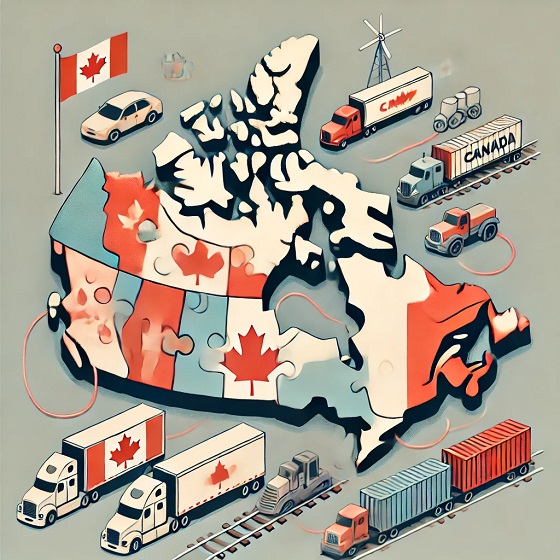Canadian Energy Centre
B.C. expects doubling of natural gas revenues with startup of LNG Canada
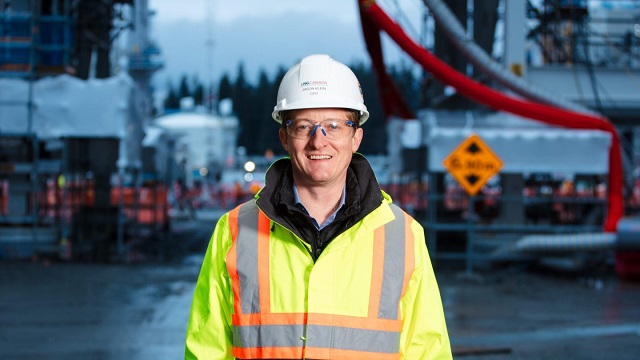
LNG Canada CEO Jason Klein. Photo courtesy LNG Canada
From the Canadian Energy Centre
By Deborah JaremkoRoyalties help pay for public services like health care, hospitals, education and schools
As Canada’s first LNG export terminal prepares for start-up, British Columbia is preparing for an influx of new revenues that will help fund government programs.
With the LNG Canada project online – expected by mid-2025 – the province expects proceeds from natural gas development will more than double.
The anticipated production of LNG by the middle of this decade boosts the province’s financial outlook, the government said in its Budget 2024.
For LNG Canada CEO Jason Klein, the coming start-up is “the launch of an entirely new Canadian industry.”
It will enable Canada’s first large-scale exports of natural gas to somewhere other than the United States.
Shipments will primarily go to Asia, where demand is expected to increase by more than 50 per cent over the next three decades, according to the U.S. Energy Information Administration.
While it’s a little over one year before the first LNG carrier will set sail through the Douglas Channel to the ocean, Klein noted the benefits are already being felt.
“More than 30,000 Canadians have worked on our project to date, with almost 9,000 Canadians employed at our Kitimat site in January this year alone,” he said.
“The cumulative value of our project’s contracts and subcontracts to local, Indigenous and other businesses in B.C. has already exceeded $4.7 billion and includes more than $3.8 billion to Indigenous-owned and local area businesses.”
Natural gas royalties paid to the province, which help pay for public services and facilities such as health care, hospitals, education and schools, are expected to rise substantially.
This year, the B.C. government expects $684 million in natural gas royalties, according to its latest annual budget. In 2027, once LNG Canada is operational, this is forecast to surge to $1.4 billion.
Globally, LNG is playing an increasingly important role in energy supply, with demand set to continue growing beyond 2040, according to Shell’s latest industry outlook.
China is likely to dominate rising LNG demand as the country’s industries look to cut carbon emissions by switching from coal to gas.
Once operational, LNG Canada will demonstrate the low-emissions advantage of Canada’s LNG supply.
“We’ve designed a project with the lowest carbon intensity of any large-scale LNG export facility operating today,” Klein said.
“[It will have] emissions that are 35 per cent lower than the world’s best performing facilities and 60 per cent lower than the global weighted average.”
Alberta
‘Existing oil sands projects deliver some of the lowest-breakeven oil in North America’
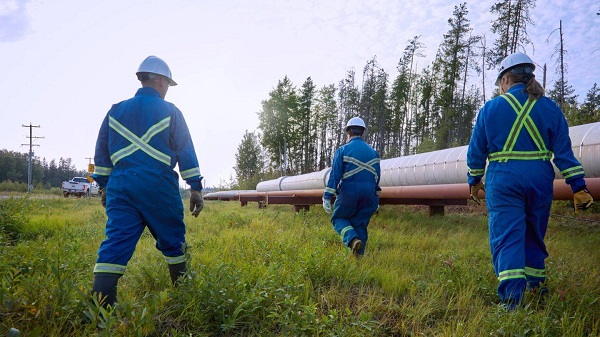
From the Canadian Energy Centre
By Will Gibson
Alberta oil sands projects poised to grow on lower costs, strong reserves
As geopolitical uncertainty ripples through global energy markets, a new report says Alberta’s oil sands sector is positioned to grow thanks to its lower costs.
Enverus Intelligence Research’s annual Oil Sands Play Fundamentals forecasts producers will boost output by 400,000 barrels per day (bbls/d) by the end of this decade through expansions of current operations.
“Existing oil sands projects deliver some of the lowest-breakeven oil in North America at WTI prices lower than $50 U.S. dollars,” said Trevor Rix, a director with the Calgary-based research firm, a subsidiary of Enverus which is headquartered in Texas with operations in Europe and Asia.
Alberta’s oil sands currently produce about 3.4 million bbls/d. Individual companies have disclosed combined proven reserves of about 30 billion barrels, or more than 20 years of current production.
A recent sector-wide reserves analysis by McDaniel & Associates found the oil sands holds about 167 billion barrels of reserves, compared to about 20 billion barrels in Texas.
While trade tensions and sustained oil price declines may marginally slow oil sands growth in the short term, most projects have already had significant capital invested and can withstand some volatility.
“While it takes a large amount of out-of-pocket capital to start an oil sands operation, they are very cost effective after that initial investment,” said veteran S&P Global analyst Kevin Birn.
“Optimization,” where companies tweak existing operations for more efficient output, has dominated oil sands growth for the past eight years, he said. These efforts have also resulted in lower cost structures.
“That’s largely shielded the oil sands from some of the inflationary costs we’ve seen in other upstream production,” Birn said.
Added pipeline capacity through expansion of the Trans Mountain system and Enbridge’s Mainline have added an incentive to expand production, Rix said.
The increased production will also spur growth in regions of western Canada, including the Montney and Duvernay, which Enverus analysts previously highlighted as increasingly crucial to meet rising worldwide energy demand.
“Increased oil sands production will see demand increase for condensate, which is used as diluent to ship bitumen by pipeline, which has positive implications for growth in drilling in liquids-rich regions such as the Montney and Duvernay,” Rix said.
2025 Federal Election
Canada’s pipeline builders ready to get to work
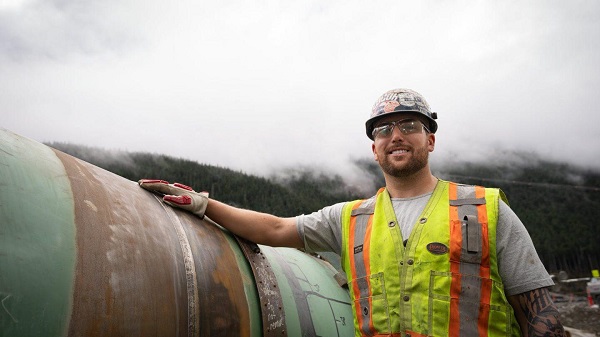
From the Canadian Energy Centre
“We’re focusing on the opportunity that Canada has, perhaps even the obligation”
It was not a call he wanted to make.
In October 2017, Kevin O’Donnell, then chief financial officer of Nisku, Alta.-based Banister Pipelines, got final word that the $16-billion Energy East pipeline was cancelled.
It was his job to pass the news down the line to reach workers who were already in the field.
“We had a crew that was working along the current TC Energy line that was ready for conversion up in Thunder Bay,” said O’Donnell, who is now executive director of the Mississauga, Ont.-based Pipe Line Contractors Association of Canada (PLCAC).
“I took the call, and they said abandon right now. Button up and abandon right now.
“It was truly surreal. It’s tough to tell your foreman, who then tells their lead hands and then you inform the unions that those three or four or five million man-hours that you expected are not going to come to fruition,” he said.

Workers guide a piece of pipe along the Trans Mountain expansion route. Photograph courtesy Trans Mountain Corporation
“They’ve got to find lesser-paying jobs where they’re not honing their craft in the pipeline sector. You’re not making the money; you’re not getting the health and dental coverage that you were getting before.”
O’Donnell estimates that PLCAC represents about 500,000 workers across Canada through the unions it works with.
With the recent completion of the Trans Mountain expansion and Coastal GasLink pipelines – and no big projects like them coming on the books – many are once again out of a job, he said.
It’s frustrating given that this could be what he called a “golden age” for building major energy infrastructure in Canada.
Together, more than 62,000 people were hired to build the Trans Mountain expansion and Coastal GasLink projects, according to company reports.
O’Donnell is particularly interested in a project like Energy East, which would link oil produced in Alberta to consumers in Eastern and Atlantic Canada, then international markets in the offshore beyond.
“I think Energy East or something similar has to happen for millions of reasons,” he said.
“The world’s demanding it. We’ve got the craft [workers], we’ve got the iron ore and we’ve got the steel. We’re talking about a nation where the workers in every province could benefit. They’re ready to build it.”

The “Golden Weld” marked mechanical completion of construction of the Trans Mountain Expansion Project on April 11, 2024. Photo courtesy Trans Mountain Corporation
That eagerness is shared by the Progressive Contractors Association of Canada (PCA), which represents about 170 construction and maintenance employers across the country.
The PCA’s newly launched “Let’s Get Building” advocacy campaign urges all parties in the Canadian federal election run to focus on getting major projects built.
“We’re focusing on the opportunity that Canada has, perhaps even the obligation,” said PCA chief executive Paul de Jong.
“Most of the companies are quite busy irrespective of the pipeline issue right now. But looking at the long term, there’s predictability and long-term strategy that they see missing.”
Top of mind is Ottawa’s Impact Assessment Act (IAA), he said, the federal law that assesses major national projects like pipelines and highways.
In 2023, the Supreme Court of Canada found that the IAA broke the rules of the Canadian constitution.
The court found unconstitutional components including federal overreach into the decision of whether a project requires an impact assessment and whether a project gets final approval to proceed.
Ottawa amended the act in the spring of 2024, but Alberta’s government found the changes didn’t fix the issues and in November launched a new legal challenge against it.
“We’d like to see the next federal administration substantially revisit the Impact Assessment Act,” de Jong said.
“The sooner these nation-building projects get underway, the sooner Canadians reap the rewards through new trading partnerships, good jobs and a more stable economy.”
-

 Business1 day ago
Business1 day agoTrump’s bizarre 51st state comments and implied support for Carney were simply a ploy to blow up trilateral trade pact
-

 Business2 days ago
Business2 days agoNew federal government plans to run larger deficits and borrow more money than predecessor’s plan
-

 Business2 days ago
Business2 days agoScott Bessent says U.S., Ukraine “ready to sign” rare earths deal
-

 International2 days ago
International2 days agoJavier Millei declassifies 1850+ files on Nazi leaders in Argentina
-

 Frontier Centre for Public Policy1 day ago
Frontier Centre for Public Policy1 day agoTrust but verify: Why COVID-19 And Kamloops Claims Demand Scientific Scrutiny
-

 Alberta1 day ago
Alberta1 day agoAlberta’s future in Canada depends on Carney’s greatest fear: Trump or Climate Change
-
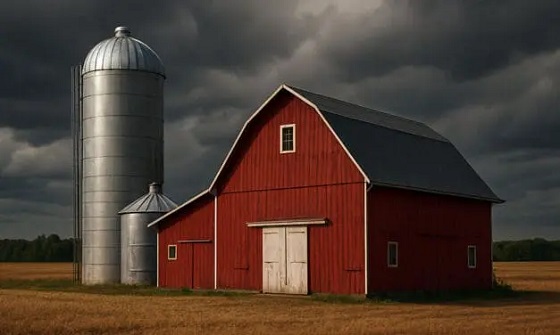
 Agriculture24 hours ago
Agriculture24 hours agoLiberal win puts Canada’s farmers and food supply at risk
-

 Automotive2 days ago
Automotive2 days agoNew federal government should pull the plug on Canada’s EV revolution









